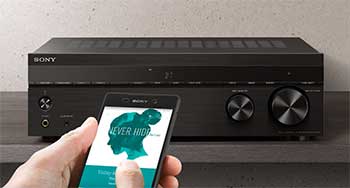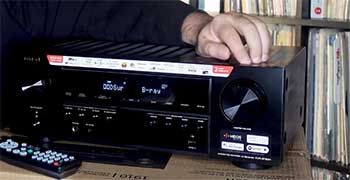Selecting the right audio/video receiver can be a daunting task with so many models and features to consider. Two popular mid-range options are the Sony STR-DH790 and Denon AVR-S760H, both priced under $500.
These 7.2 channel receivers pack in performance and connectivity that belies their budget price point. Let’s take an in-depth look at how these two receivers stack up.
A Brief Comparison Table
| Specs | Sony STR-DH790 | Denon AVR-S760H |
| Power | 95W/channel | 75W/channel |
| HDMI | 2.0b | 2.1 |
| HDR | HDR10, HLG | HDR10, HLG, Dolby Vision |
| Surround Sound | Dolby Atmos, DTS:X | Dolby Atmos, DTS:X, DTS Neural:X |
| Streaming | Chromecast, Airplay 2 | HEOS |
| Multi-Zone | 2 zones | 2 zones simultaneously or 3 zones total |
| Room Correction | MultEQ XT | Audyssey MultEQ |
| Warranty | 2 years | 3 years |
| Price | $350-$400 | $450-$500 |
Key Specs And Features
The Sony STR-DH790 is rated at 95 watts per channel into 8 ohms, 20 Hz–20 kHz, 0.09% THD, 2-ch driven, while the Denon AVR-S760H is spec’d at 75 watts per channel into 8 ohms, 20Hz – 20kHz, 0.08% 2 channels driven. So the Sony has a bit more power on tap, which could come in handy for powering less sensitive speakers.

Both receivers support the latest surround formats including Dolby Atmos and DTS:X for immersive 3D audio. DTS Virtual:X is also included to expand stereo and 5.1 content for a more enveloping surround experience. The Denon adds DTS Neural:X upmixing for non-DTS formats.
For video, the AVR-S760H has a leg up with HDMI 2.1 compatibility and eARC (enhanced Audio Return Channel) support versus the STR-DH790’s HDMI 2.0b spec. This gives the Denon an advantage for 8K video passthrough and other 2.1 features down the road. Both have 4K/60p and HDR10/HLG high dynamic range playback. But only the Denon handles Dolby Vision HDR which has wider adoption compared to Sony’s Hybrid Log Gamma (HLG).
In terms of connectivity, each receiver provides 5 HDMI inputs and 2 outputs with support for HDCP 2.3 copyright protection. The STR-DH790 adds a 6th HDMI input on the front panel which can be handy for quick connections. Both have a generous allotment of analog and digital audio inputs for connecting audio sources. The Denon tacks on HEOS wireless multiroom streaming while the Sony counters with built-in Bluetooth and NFC pairing.
Also Read: Should You Buy Panasonic UB420 Or UB820?
Ease Of Setup And Use
The on-screen setup wizards on the Sony and Denon make the initial configuration process quick and painless. Inputs can be labeled and icons assigned to clearly identify connected devices. Both use Audyssey room correction software for automatic speaker calibration – MultEQ on the Denon and MultEQ XT on the Sony for more measurement points. The Sony also supports AccuEQ room calibration if preferred.
In daily operation, the intuive remote controls make it easy to switch inputs and sound modes on the fly. Each receiver can also be controlled via apps on iOS and Android mobile devices. Voice control is available through Amazon Alexa, Google Assistant and Siri using Alexa-enabled, Google Home and AirPlay 2 devices respectively.
The Sony plays nice right out of the box with Sony TVs. thanks to Control for HDMI (BRAVIA Sync) integration. The STR-DH790 display provides simple status information without the need to turn on a TV. Overall the Sony menu system offers better ease of use compared to the busier Denon interface.
Sound Quality And Features
With their built-in amplification, these receivers deliver clean power to all channels without needing separate amps. Sound quality is bold and dynamic thanks to high current discrete power supplies. The beefier Sony is able to drive larger speakers to higher volumes with greater stability.

To tune the sound, the Denon packs in more processing like Audyssey Dynamic EQ for improved surround effects at lower volume levels. It also includes a more advanced 32-bit DAC (Vs. Sony’s 192kHz/24-bit) and subwoofer EQ to tame overzealous bass. The Sony provides more basic bass/treble adjustments and audio presets.
For music, the Denon’s HEOS wireless streaming provides access to streaming services like Spotify, Pandora, Tidal and more. Sony lacks onboard streaming but is compatible with Google Chromecast and Airplay 2. The STR-DH790 boasts better compatibility with popular hi-res audio formats like DSD (up to 11.2 MHz), FLAC 192 kHz/24-bit and ALAC 96 kHz/24-bit. The front USB input can also play music from flash drives.
Both receivers offer multi-zone capabilities – the Sony supports 2 zones while the Denon can drive 2 zones simultaneously or power up to 3 zones. The Denon’s Zone B line-out could come in handy for connecting an external amp in another room. Only the Denon provides 12V trigger output for automation control.
Design Aesthetics
The Sony STR-DNH790 sports a sleek, angular design clad in black. The Denon AVR-S760H follows a more traditional squared-off look but still looks sharp with its black finish. Each receiver keeps controls to a minimum with smooth front panels. The Sony stands at 14 1/2 inches wide – almost three inches narrower compared to the Denon. While not petite, these receivers aren’t as bulky as higher-end counterparts and work in modest home theater spaces.
Display elements favor subtlety – the Sony opts for small LED indicators with no front display panel. The Denon takes a hybrid approach with a small LED readout plus on-board setup menus. For rack mounting, both carry half-rack widths but the Denon includes removable feet while the Sony does not. This gives the Denon an advantage for custom installs. Overall the stylish Sony gets the nod for aesthetics and compact footprint.
Reliability And Support
Sony and Denon are both established brands that manufacture reliable electronics backed by warrants. The Sony STR-DH790 warranty provides 2 years coverage while Denon offers 3 years, indicating a higher level of confidence. Both warranties cover parts and labor in case of defects.
Customer and technical support is available by phone, email or online chat for both brands. Sony phone support operates shorter hours while Denon provides 24/7 customer service. Denon’s website offers more extensive manuals, troubleshooting tips and video tutorials. But Sony counters with an active user community for DIY advice. Either brand provides sufficient backing though Denon’s superior warranty and customer service earns a reliability advantage.
Also watch the video of Sony STR-DH790!
Pricing And Value
At around $350-$400, the Sony STR-DH790 delivers strong performance and usability at an attractive price point. The Denon AVR-S760H costs $100 more on average but justifies the extra expense with more advanced video capabilities, streaming features and room correction. The additional HDMI 2.1 support also future-proofs the Denon to work with next-gen devices.
Both receivers provide ample power and connectivity in a compact form factor that outshines budget models. Considering the performance obtained, each is a great value though the Denon AVR-S760H justifies its premium price with more robust features. But for buyers who don’t need cutting-edge specs, the Sony STR-DH790 gets the job done for less.
Frequently Asked Questions (FAQ)
The Denon AVR-S760H is rated at 75 watts per channel into 8 ohms, 20Hz – 20kHz, 0.08% 2 channels driven.
Yes, the Denon AVR-S760H supports the latest Dolby Atmos and DTS:X surround formats.
Yes, the AVR-S760H is compatible with Dolby Vision HDR (High Dynamic Range) video.
Yes, the Denon AVR-S760H supports 2-zone simultaneous playback or up to 3 zones in total.
Also Read: Is Rockville Better Than Pyle?
The Verdict
The Sony STR-DH790 and Denon AVR-S760H represent sound choices for budget home theater. While the Denon wins on paper with higher-end features, the Sony keeps up performance-wise and offers better usability out of the box.
Those needing the latest standards like HDMI 2.1 and Dolby Vision will prefer the more future-proof Denon. Media streamers get greater flexibility from HEOS built-in streaming and multi-zone support.
However, the Sony is no slouch with its solid A/V foundation and user-friendly experience. For many buyers, saving $100+ and still getting robust performance will be appealing. You can’t go wrong either way, but analyze your needs to pick the receiver that’s the best match.